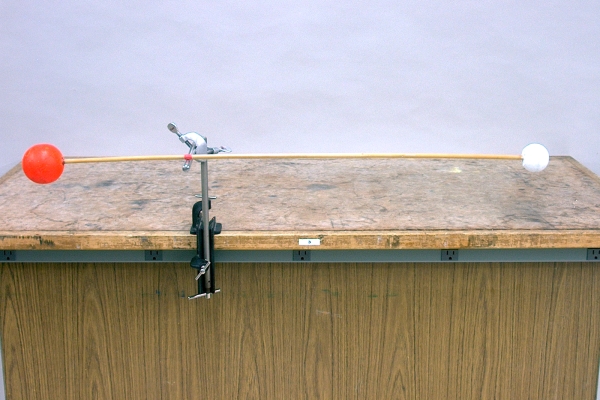
A video of this demonstration is available at this link.
A wood rod with different-sized balls attached to its ends is balanced at its center of mass.

A video of this demonstration is available at this link.
A wood rod with different-sized balls attached to its ends is balanced at its center of mass.
The center of mass of an object is the weighted mean displacement of all of its mass points from some reference point, usually the origin of the coordinate system in which the object sits. This is the sum of the products of all the mass points with their distances from the origin, divided by the total mass of the object (rcm = Σmiri/M). If we set the center of mass of the object at the origin, we find that this sum equals zero. This tells us that if we exert a force on the object at its center of mass, this results in no torque on the object, but if we apply a force to the object at any other point, as long as the line of force does not go through the center of mass, we exert a torque on the object about its center of mass.
The mass of the orange ball at the left end of the rod in the photograph is about 2.4 times that of the white ball at the other end. The point at which their moments (the products in the sum shown above) are equal and opposite is the center of mass of the system (if we neglect the net moment of the rod, which is small compared to that of either ball). This is the point at which we can support the rod without exerting a torque; it is the balance point.
We can find the center of mass of this sytem in an interesting way. We can support the rod by placing a finger against the ball at each end, and then slide our fingers together. The force of static friction between the rod and each finger is in inverse proportion to the distance of that finger from the center of mass. Thus, at the start, the static friction between the rod and the finger at the white ball is less than that between the rod and the finger at the orange ball. So the finger at the white ball begins to slide first. It then reaches a point where the kinetic friction between it and the rod just exceeds the static friction between the rod and the finger at the orange ball, and that finger begins to slide, while the first finger stops sliding. The finger that started at the orange ball slides until it reaches the point where the kinetic friction between it and the rod just exceeds the static friction between the first finger and the rod, and the first finger begins to slide again, while the second finger now stops sliding. This cycle repeats until both fingers come together at the center of mass. As the photograph above shows, a piece of red tape marks the location of the center of mass of the system.
References:
1) Ehrlich, Robert. Turning the World Inside Out and 174 Other Simple Physics Demonstrations (Princeton, New Jersey: Princeton University Press, 1990) p. 49.